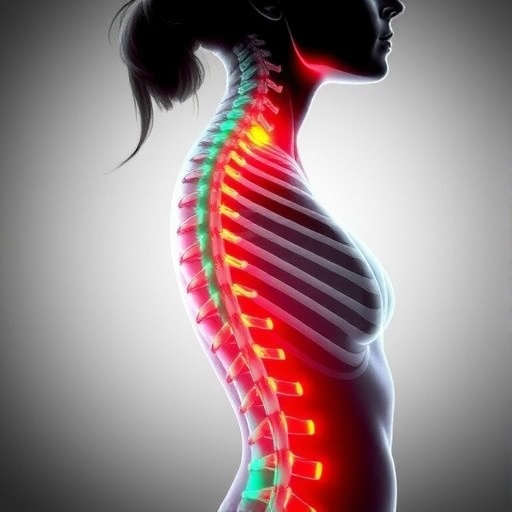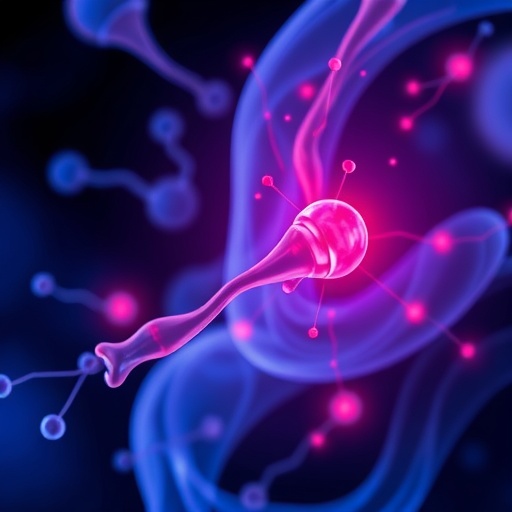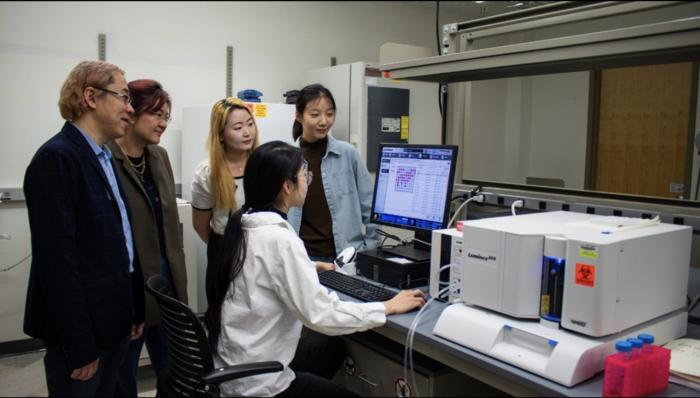In a groundbreaking study that sheds light on the complex biological mechanisms underlying adolescent idiopathic scoliosis (AIS), researchers have unveiled significant findings through sophisticated plasma exosome proteomics. This innovative approach has revealed a marked upregulation of cartilage intermediate layer protein 1 (CILP-1) specifically in the concave side of the paraspinal muscle among adolescents afflicted with this spinal deformity. The implications of these findings are vast, potentially paving the way for novel diagnostic tools and therapeutic interventions targeted at AIS, a condition affecting approximately 2-3% of adolescents.
The key focus of the study centers around plasma exosomes, small extracellular vesicles that facilitate intercellular communication and are critical to the transport of proteins, lipids, and RNAs. By utilizing advanced proteomics techniques, the researchers were able to analyze the protein composition of these exosomes, highlighting changes indicative of underlying pathophysiological processes. This particular investigation marks a significant stride in understanding the molecular landscape influences that contribute to the development and progression of AIS.
One of the notable characteristics of AIS is its multifactorial etiology, including genetic, environmental, and biomechanical factors. Traditional diagnostics have primarily focused on the physical examination and imaging techniques, which serve to assess the curvature of the spine. However, this new proteomic analysis introduces a fresh perspective by examining the molecular changes occurring at the cellular level, potentially allowing for earlier detection of the condition before it manifests physically. The identification of specific protein markers, such as CILP-1, could lead to the development of blood tests that serve as important diagnostic adjuncts for physicians.
The researchers discovered that the levels of CILP-1 were significantly elevated in the plasma exosomes derived from adolescents with AIS, particularly on the concave side of the paraspinal muscles. CILP-1 is known to play a role in cartilage homeostasis and may interact with various signaling pathways that regulate the remodeling and structural integrity of the musculoskeletal system. This suggests that changes in CILP-1 levels may reflect alterations in muscle tension and biomechanical stresses experienced in the spinal region, thus linking the protein to the unique curvature patterns observed in scoliosis.
Moreover, this groundbreaking work emphasizes the importance of understanding the role of the local muscle environment in scoliosis development. The paraspinal muscles provide crucial support to the spine, and any imbalance in the forces exerted by these muscles can lead to exacerbated spinal deformities. The discovery of elevated CILP-1 levels could indicate a physiological response to altered muscle dynamics, suggesting that targeted therapies aimed at normalizing these levels may have potential in treating or even preventing the progression of scoliosis.
In addition to its immediate implications in understanding AIS, the findings of this study also contribute to the broader field of musculoskeletal research. The analysis of plasma exosomes presents a unique opportunity to explore biomarkers related to various orthopedic conditions and offers a non-invasive method for monitoring disease progression. As researchers continue to delve into the complexities of exosome biology, the potential for discovering additional molecular players in other musculoskeletal disorders remains vast.
The adoption of proteomic technologies in the realm of orthopedic research is rapidly gaining momentum, exposing new pathways and mechanisms previously unexplored. The ability to profile exosomal proteins adds a valuable layer to our understanding of how systemic factors influence local tissue responses, bringing to light the interconnectedness of bodily systems in the context of disease. As this field evolves, we may witness a paradigm shift toward more personalized treatments that take into account an individual’s unique biological makeup.
Furthermore, the prospect of therapeutic interventions targeting CILP-1 opens up avenues for innovative approaches to manage and treat AIS. While surgery remains an option for severe cases, understanding the molecular alterations associated with scoliosis could render non-invasive alternatives more viable. Future studies could investigate the potential of pharmacological modulation of CILP-1 expression as a means to relieve or correct spinal deformities, transforming the landscape of how we approach this condition.
There is also a pressing need for longitudinal studies to trace the variations of CILP-1 levels over time and correlate these fluctuations with clinical outcomes in adolescent scoliosis patients. By establishing a timeline of these biomolecular changes, researchers may be able to identify critical windows for intervention and develop strategies to halt or reverse disease progression before surgical measures become necessary.
As findings continue to unfold, collaborative efforts among multidisciplinary teams—including geneticists, orthopedists, and proteomic specialists—will be crucial in translating these discoveries into clinical practice. This research exemplifies the convergence of cutting-edge science and its application to real-world challenges, serving as a testament to the potential that lies within interdisciplinary cooperation.
In conclusion, the study by Wang et al. marks a significant advancement in our understanding of adolescent idiopathic scoliosis through the lens of plasma exosome proteomics. The delineation of upregulated CILP-1 on the concave side of the paraspinal muscles signifies a major breakthrough in our quest to decipher the molecular foundations of this condition. As researchers aspire to leverage this knowledge into tangible benefits for patients, we find ourselves on the brink of a new era in scoliosis management—one where diagnostic precision and targeted treatment may ultimately improve outcomes and quality of life for adolescents grappling with this challenging condition.
Subject of Research: Adolescent Idiopathic Scoliosis and Plasma Exosome Proteomics
Article Title: Plasma exosome proteomics reveals upregulation of CILP-1 in concave side of paraspinal muscle in adolescent idiopathic scoliosis.
Article References:
Wang, Q., Wang, C., Wang, L. et al. Plasma exosome proteomics reveals upregulation of CILP-1 in concave side of paraspinal muscle in adolescent idiopathic scoliosis. Clin Proteom 22, 23 (2025). https://doi.org/10.1186/s12014-025-09542-8
Image Credits: AI Generated
DOI:
Keywords: Adolescent Idiopathic Scoliosis, CILP-1, Plasma Exosomes, Proteomics, Biomarkers, Musculoskeletal Disorders.
Tags: adolescent idiopathic scoliosis researchadvanced proteomics in medical researchbiological mechanisms of scoliosisCILP-1 expression in scoliosisintercellular communication in spinal deformitiesmultifactorial causes of scoliosisnovel diagnostic tools for scoliosisparaspinal muscle changes in AISpathophysiological processes in AISplasma exosome proteomics studyscoliosis biomarker discoverytherapeutic interventions for adolescent scoliosis






